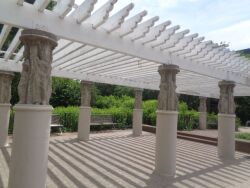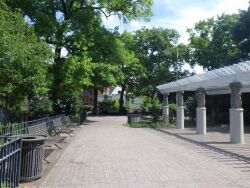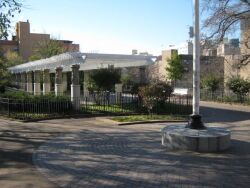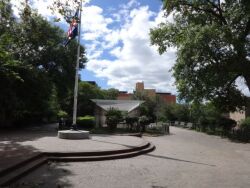Charlton-Thompson Garden
Charlton Garden
What was here before?
Originally inhabited by the Lenape, this parcel was later part of Welsh merchant Richard Morris’s (1730-1810) property. The site was inherited by “founding father”, Gouverneur Morris (1752-1816) in the late 18th century, and his son ultimately divided the property for development. James R. Marvin (1831-1896), a prominent lawyer, purchased this plot. Marvin worked for the Village of Morrisania before the consolidation of the boroughs and as counsel to his neighbor and furniture magnate, Henry P. DeGraaf.
How did this site become a garden?
The City acquired the property in 1916 and assigned it to the Parks Department in 1930, and the park opened five years later. More land was added in 1945, and in 1952, the City Council passed a local law that named the property in honor of Sergeant Cornelius H. Charlton (1929-1951).
In 2011 the garden was reconstructed with a rebuilt pergola, expanded planted areas, reconstructed entrance, ADA-compliant ramp, decorative pavers, fencing, lighting, and a new flagpole with a stone base that includes inscriptions honoring both Charlton and fellow Medal of Honor recipient Pfc. William Thompson (1927-1950).
Who is this garden named for?
Sergeant Cornelius H. Charlton was a Korean War Congressional Medal of Honor recipient.
Charlton was born in East Gulf, West Virginia, and later moved to the Bronx, where he enlisted in the Army at the onset of the Korean War (1950-1953). Originally assigned to a desk position, Charlton volunteered for combat duty with Company C in the 24th Infantry Regiment of the 25th Army Infantry Division which was the last segregated Buffalo Soldier regiment to be integrated. On June 2, 1951, Charlton’s platoon commander was seriously wounded. Charlton assumed command of the platoon, rallied the men, and re-launched the attack. The platoon suffered heavy casualties and faltered, but Charlton regrouped the men and launched a second attack. He received a severe chest wound but refused medical attention and led a third charge, which advanced his men to the crest of a hill. Seeing the remaining strongpoint on the opposite hill, he charged it alone. Charlton was hit by another grenade but lived long enough to destroy the enemy position.
Although Sergeant Charlton received the Congressional Medal of Honor and the Purple Heart posthumously in 1952, he was not buried in Arlington National Cemetery due to racism. Instead, he was buried in the segregated Bryant Cemetery in Bramwell, West Virginia. In 1989, the Medal of Honor Society exhumed Charlton’s grave and subsequently re-interred his remains in the American Legion Cemetery in Beckley, West Virginia. In 2008, the sergeant finally received full honors, and his remains were interred in front of friends and family at Arlington, 56 years after his combat death in Korea.
Thompson was born in Brooklyn and enlisted in the Army in the Bronx. He was stationed in Alaska before he reenlisted and was put on occupation duty in South Korea. Thompson was in the 24th Infantry, an all-Black unit, and first saw combat in the Battle of Sangju where they were forced to retreat.
On August 6, 1950, Thompson’s unit was attacked while clearing a hamlet of Haman, South Korea. As Thompson was engaging with the South Koreans, he was ordered to retreat due to the amount of firepower in the direction of his platoon. He refused, saying, “Get out of here! I’ll cover you.” The rest of his company was able to get a better defensive position, but Thompson died during the assault and his body was recovered a few days later. He is buried at Long Island National Cemetery. PFC Thompson was the first African American to be awarded the Medal of Honor.
Check out your park's Vital Signs
Clean & Safe
Green & Resilient
Empowered & Engaged Users
Share your feedback or learn more about how this park is part of a
Vital Park System




